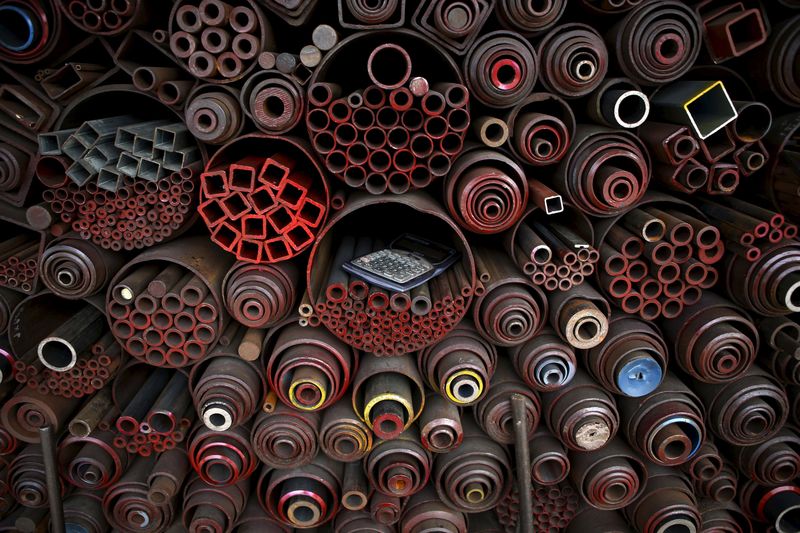(Repeats with no changes to text)
By Clyde Russell
LAUNCESTON, Australia, April 21 (Reuters) - - Is iron ore's rapid move from one of the commodities with the gloomiest outlook to a star performer justifiable and sustainable?
At the start of this year, iron ore looked to be trapped in a vicious cycle of massive oversupply coupled with a declining demand profile.
But Asian spot prices .IO62-CNI=SI have rallied almost 50 percent since the beginning of 2016, confounding analysts, myself included, who had predicted that any rally was merely an opportunity to take profits and go short again.
This means it's worthwhile looking at what has changed in the iron ore market, and whether these changes are structural or more temporary in nature.
The two major drivers have been some reductions in the expected amount of supply of the steel-making ingredient, coupled with better-than-expected demand as China acts to boost its economy through fixed asset investment (FAI).
Taking supply first, and this week has seen the world's top three producers all scale back their expected output.
Rio Tinto (LON:RIO) RIO.AX led the way, announcing on April 19 a cut to its 2017 production forecast to between 330 million and 340 million tonnes from a prior forecast of 350 million. a cut of as much as 20 million tonnes from the market, but the key point is the reduction is only for next year.
For 2016 Rio kept its forecast at a record 350 million tonnes, and reported first-quarter shipments of 80.8 million tonnes, up 11.4 percent from the same period a year earlier.
BHP Billiton (LON:BLT) BHP.AX , the number three producer, on Wednesday cut its output forecast for the year to June 2016 by 10 million tonnes to 260 million, blaming a cyclone that disrupted operations at its Western Australia operations. had already lowered its forecast by 10 million tonnes in January to account for the loss of its share of output from the Samarco mine in Brazil, which was shuttered after a dam disaster.
Top producer Vale VALE5.SA joined its Anglo-Australian rivals by announcing on Wednesday that its full-year iron ore output will come in at the lower end of its 340 million-350 million tonne target. the Brazilian giant also remains on track to lift production to between 380 and 400 million tonnes in 2017 as it ramps up its new S11D mine.
It appears that the supply cutbacks announced for this year by BHP and Vale have been enough to give a sense that the iron ore market has tightened enough to support prices.
Together, BHP and Vale may produce about 30 million tonnes less than they had forecast, equivalent to about one-third of one month's imports by China, the world's top buyer.
While this is a big enough number to drive some positive sentiment, it's also likely that it will be offset by supply additions, most notably from Roy Hill, the new 56-million tonne a year mine in Western Australia that's starting to ramp up output.
Overall, from the supply side, there hasn't been a structural move to reduce output, rather a few temporary factors have tightened the market for the time being, but its hard to see this persisting into 2017.
CHINA SPENDING DRIVES DEMAND
On the demand side it does appear China has ramped up stimulus spending, with FAI rising 10.7 percent in the first quarter of the year, helping steel output to reach a record high in March.
Steel production has been incentivised by strong gains in Shanghai rebar prices, with the benchmark contract SRBcv1 jumping 48.3 percent from the start of the year to Wednesday's close of 2,561 yuan ($395) a tonne.
It's likely that the stimulus spending still has a little while to run, but that doesn't necessarily mean that steel prices will continue to rally strongly.
The higher prices will simply bring more output back on line, as well as preventing loss-making mills from closing.
Given excess capacity in China's steel sector runs into hundreds of millions of tonnes, there's little doubt that very soon supply can overwhelm even rising demand, making a pullback in steel prices more or less inevitable.
Add to that rising discontent among global steel producers and their respective governments over cheap Chinese exports, and it's hard to envisage an environment of sustained output gains in the world's largest producer.
Given the close correlation between Shanghai steel prices and spot iron ore, any pullback in the former is likely to drag down the latter.
Taking supply and demand together, there is a fairly strong case to be made for iron ore to be more positive currently, but whether that argument is robust enough to back the extension of a 50 percent price rally is less certain.
However, the market saying that the trend is your friend is a cliché because it has been proven time and again.
So for the time being iron ore may continue to post gains, at least until supply does rise and demand levels off, but it's still likely that iron ore is experiencing a bear market rally, rather than a structural change to a more balanced market.
(Editing by Himani Sarkar)
